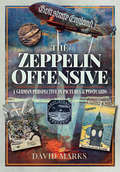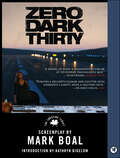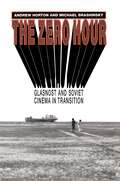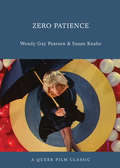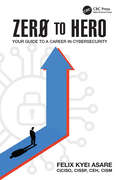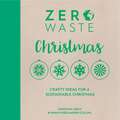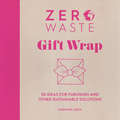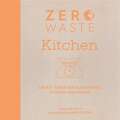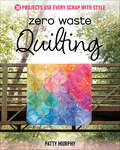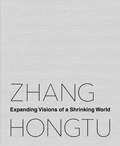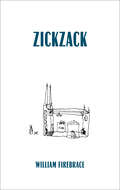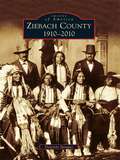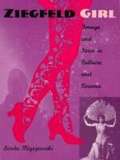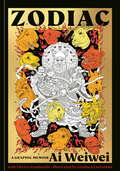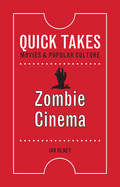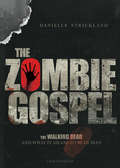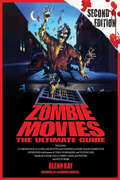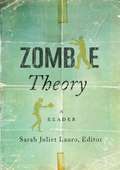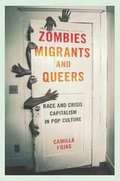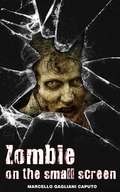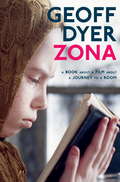- Table View
- List View
The Zeppelin Offensive: A German Perspective in Pictures and Postcards
by David MarksAirship propaganda that&’s &“a visual treat . . . it will appeal to all those interested in how artwork was harnessed to convey information in time of war&” (Firetrench). Books on the Zeppelin raids during the First World War have, traditionally, focused on the direct impact of Britain, from the devastating effects on undefended towns and cities, the psychological impact of this first weapon of total war to the technological and strategic advances that eventually defeated the &“Baby Killers.&” Now, drawing on the largest postcard collection of its kind and other period memorabilia, David Marks tells the story of the Zeppelin during the First World War from a viewpoint that has rarely been considered: Germany itself. From its maiden flight in July 1900, the Zeppelin evolved into a symbol of technology and national pride that, once war was declared, was at the forefront of German&’s propaganda campaign. The Zeppelin links the rampant xenophobia at the outbreak of the conflict against England (it almost never was called Britain), France, Russia and their allies to the political doctrines of the day. The postcards that profusely illustrate this book show the wide-ranging types of propaganda from strident Teutonic imagery, myths and legends, biting satire and a surprising amount of humor. This book is a unique contribution to our understanding of the place of the Zeppelin in Germany&’s culture and society during the First World War. &“Well-recommended for its unique visual and psychological insights.&” —Over the Front &“Perfectly conveys the early optimism of the Zeppelin as both a symbol of national prestige and the weapon which would win the War.&” —Donna&’s Book Blog
Zero-Carbon Homes: A Road Map
by Joanna WilliamsHousing is a major contributor to CO2 emissions in Europe and America today and the construction of new homes offers an opportunity to address this issue. Providing homes that achieve "zero carbon", "carbon neutral", "zero-net energy" or "energy-plus" standard is becoming the goal of more innovative house-builders globally, whilst energy providers seek to decarbonise the energy supply to new and existing development. Various new technical systems for achieving these goals are beginning to emerge. For example the passive house whose energy requirement for space heating and cooling is almost zero; the smart grid that has revolutionized the management of energy, whilst enabling the connection of small-scale, renewable energy producers and electric vehicles to the grid; or the European super-grid which will enable zero carbon energy to be generated in the Sahara desert and stored in Norway. This book explores the diverse approaches that are being adopted around the world to deliver zero carbon homes and the different societal systems and geographic circumstances in which they have developed. It postulates a roadmap for delivering zero carbon homes, together with a toolbox approach for policy and practice to suit particular national and local circumstances. A series of case studies are presented that offer lessons for delivering zero carbon homes. These examples are also used to demonstrate how prototype systems can move into the mainstream. The book highlights some of the instruments and mechanisms that could be used to support this transformation and addresses the wider implications of introducing these innovative systems in terms of industry, lifestyle and urban form.
Zero Dark Thirty: The Shooting Script (Shooting Script Ser.)
by Mark BoalThe hunt for Osama bin Laden preoccupied the world and two American presidential administrations for more than a decade. But in the end, it took a small, dedicated team of CIA operatives to track him down. Every aspect of their mission was shrouded in secrecy. Though some of the details have since been made public, many of the most significant parts of the intelligence operation—including the central role played by that team—are brought to the screen for the first time in a nuanced and gripping new film by the Oscar®-winning creative duo of Kathryn Bigelow and Mark Boal, starring Jessica Chastain, Jason Clarke, Joel Edgerton, Jennifer Ehle, Mark Strong, Kyle Chandler, and Edgar Ramirez.The Newmarket Shooting Script Book includes: Introduction by Kathryn Bigelow Complete shooting script Q&A with Mark Boal by Rob Feld Production notes Storyboards Complete cast and crew credits
The Zero Hour: Glasnost and Soviet Cinema in Transition
by Andrew Horton Michael BrashinskyNow faced with the "zero hour" created by a new freedom of expression and the dramatic breakup of the Soviet Union, Soviet cinema has recently become one of the most interesting in the world, aesthetically as well as politically. How have Soviet filmmakers responded to the challenges of glasnost? To answer this question, the American film scholar Andrew Horton and the Soviet critic Michael Brashinsky offer the first book-length study of the rapid changes in Soviet cinema that have been taking place since 1985. What emerges from their collaborative dialogue is not only a valuable work of film criticism but also a fascinating study of contemporary Soviet culture in general. Horton and Brashinsky examine a wide variety of films from BOMZH (initials standing for homeless drifter) through Taxi Blues and the glasnost blockbuster Little Vera to the Latvian documentary Is It Easy to Be Young? and the "new wave" productions of the "Wild Kazakh boys." The authors argue that the medium that once served the Party became a major catalyst for the deconstruction of socialism, especially through documentary filmmaking. Special attention is paid to how filmmakers from 1985 through 1990 represent the newly "discovered" past of the pre-glasnost era and how they depict troubled youth and conflicts over the role of women in society. The book also emphasizes the evolving uses of comedy and satire and the incorporation of "genre film" techniques into a new popular cinema. An intriguing discussion of films of Georgia, Estonia, Latvia, Lithuania, and Kazakhstan ends the work.
Zero Patience: A Queer Film Classic
by Susan Knabe Wendy Gay PearsonA Queer Film Classic on John Greyson's controversial 1993 film musical about the AIDS crisis which combines experimental, camp musical, and documentary aesthetics while refuting the legend of Patient Zero, the male flight attendant accused in Randy Shilts' book And the Band Played On of bringing the AIDS crisis to North America. Wendy Gay Pearson and Susan Knabe both teach in the women's studies and Feminist Research department at the University of Western Ontario. Arsenal's Queer Film Classics series cover some of the most important and influential films about and by LGBTQ people.
Zero to Hero: Your Guide to a Career in Cybersecurity
by Felix Kyei AsareZero to Hero: Your Guide to a Career in Cybersecurity is an essential roadmap for anyone aiming to penetrate the vibrant and ever-expanding domain of cybersecurity. In an era where digital threats loom larger and more complex than ever, this book stands as a beacon of clarity and practical wisdom. Tailored for novices and those with basic understanding, this resource empowers learners to solidify their cybersecurity foundation. It stands out with its laser focus on real-world applicability, ensuring readers grasp theoretical concepts and can implement them effectively.Key Features of This Guide: Actionable Learning: Dive into engaging exercises, compelling case studies, and practical scenarios that demystify complex cybersecurity concepts Career Development: Gain invaluable insights into crafting a standout resume, navigating job interviews with confidence, and learning strategies for a successful job hunt in the cybersecurity realm Cutting-Edge Knowledge: Stay ahead of the curve with detailed explorations of the latest cybersecurity trends, tools, and technologies that are shaping the future of digital security In-Depth Discussions: From ethical hacking to digital forensics, explore the breadth and depth of the cybersecurity field, ensuring a comprehensive understanding of various career paths Progressive Skill-Building: Embark on a structured learning journey, from foundational concepts to advanced techniques, tailored to foster a deep, actionable understanding of cybersecurity Zero to Hero: Your Guide to a Career in Cybersecurity is your launchpad into the heart of the industry. Perfect for students, career changers, and IT professionals, this book provides the essential knowledge and skills to secure a rewarding career in this critical field. Begin your journey from novice to expert in cybersecurity today!
Zero Waste Christmas: Crafty Ideas for a Sustainable Christmas
by Christine Leech Emma Friedlander-CollinsCelebrate Christmas the zero-waste way with these crafty solutions for everything from Christmas tree decorations to advent calendars. The zero-waste movement is huge and this collection of crafty ideas will help you to create your own zero waste solutions for a sustainable Christmas. It's time to reclaim Christmas - this collection is all about using the things around you to bring festive cheer to your home. It's about crafting and creating together and using what you've got to make unique, unusual items that you can enjoy year after year. By crafting your zero-waste Christmas you are also creating memories ; something that cannot be bought online. Upcycling and reuse gurus Emma Friedlander-Collins and Christine Leech show you how to turn Christmas into a zero-waste experience with step-by-step instructions and some clever crafting. Whether you're a committed crafter or new to making, there is something for everyone no matter what your skill level is. Choose from projects and tutorials for a sustainable Christmas including sewing, crochet, upcycling and reuse ideas. You don't need to have lots of craft skills to create these projects, there are step-by-step instructions for each one. There are also instructions for the basic craft techniques such as crochet and embroidery so you can get stuck in straightaway. There are four different Christmas themed chapters: Hot; Frosty; Skandi and Retro so you pick your favourite style or mix and match for festive mash-up! Projects include Coffee Cup Baubles; a minimalist wreath made using an old cake tin; a milk carton advent calendar and some magical fairy lights made using takeaway containers. Choose your favourite projects from this collection of 24 projects including no-waste decorations for the tree and zero-waste gift wrap. Packed full of original ideas, Zero Waste: Christmas will help you to celebrate the zero-waste way and improve your efforts to reduce, reuse and recycle while at the same time having fun.
Zero Waste Gift Wrap
by Christine LeechInventive ways to wrap presents that are both pretty and planet-friendly!Embrace zero waste living with this collection of sustainable gift wrap solutions including furoshiki, the traditional Japanese technique of fabric knotting. What could be nicer than receiving a present AND the beautiful scarf it's wrapped in!Whether you use a vintage silk scarf or create your own fabric with patchwork, piecing, and dyeing techniques—or reuse unwanted items to make quirky gift wraps—this collection is packed full of ideas for reducing waste.Other ideas include how to make present toppers made from unwanted fabric and yarn scraps—to finish off your gift wrapping with a flourish.
Zero Waste Kitchen: Crafty Ideas for Sustainable Kitchen Solutions
by Christine Leech Emma Friedlander-CollinsTurn your kitchen into a waste-free zone with these crafty solutions for everything from 'unpaper' towels to reusable kitchen wipes and clever storage solutions. The zero waste movement is huge and this collection will help you to craft your own zero waste solutions - with just a few craft skills you will be able to turn your unwanted waste into storage and cleaning items for your kitchen. The kitchen is the heart of our homes and finding ways to make it feel healthy and wholesome are really important. From leftover food scraps to the endless packaging that our food comes in, there's so much that goes on in a kitchen and it's the place in our homes where we generate the mosts waste. Make your kitchen more sustainable with some clever craft ideas for reusing, upcycling and transforming waste. Whether you're a committed crafter or new to making, there is something for everyone no matter what your skill level is. Choose from projects and tutorials for the kitchen including sewing, crochet, patchwork, upcycling and reuse ideas. There are also some projects that require cutting, sticking and even drilling thrown in for good measure: learning how to do little bits of everything will give you a 'toolkit' to think creatively about how to reuse everyday things as you progress on your journey to zero waste living. Learn how to use up fabric scraps and old linen to create beeswax wraps for storing food; make your own paper caddy liners for food waste and create pots for growing kitchen herbs from empty bottles. Create a unique and practical apron from an old pair of thrifted curtains and sew some handy storage ideas for the family using pockets rescued from unwanted clothes. Upcycling and reuse gurus Emma Friedlander-Collins and Christine Leech show you how to turn your kitchen into a zero-waste zone with step-by-step instructions and some clever crafting. Packed full of original ideas, Zero Waste: Kitchen will help you to live the zero-waste way and improve your efforts to reduce, reuse and recycle while at the same time having fun.
Zero Waste Quilting: 38 Projects Use Every Scrap with Style
by Patty MurphyCraft stunning quilts while being resource-savvy. Revolutionize your approach to quilting by eliminating fabric waste and embracing sustainable crafting. Each project serves as a catalyst for additional projects, using all the scraps and leftovers. This mindful approach—intentional fabric buying, using what you have, augmenting as needed, and minimizing waste—embraces purposeful designs in a collection of beautiful projects. Zero Waste Quilting offers practical insights into sustainable crafting by exploring how to use your stash, shop responsibly, and evaluate leftover fabric. As a bonus, you’ll find resources for additional reading, informed viewing, and profiles of shops offering responsibly sourced fabric. Make every stitch count by bridging the gap between crafting and being environmentally conscious. Create stunning quilts with confidence and whip up the related projects to use every last bit and piece of leftover fabric, resulting in zero waste Discover innovative and unique tips to turn the tiniest fabric scraps into fresh projects while lessening your impact on the environment Learn how to creatively incorporate off-cuts and leftovers into charming works of art
Zhang Hongtu: Expanding Visions of a Shrinking World
by Jerome Silbergeld Luchia Meihua LeeIn this book, leading art experts, art historians, and critics review the life, career, and artistic development of New York based Chinese artist Zhang Hongtu. A pioneer in contemporary Chinese art, Zhang created the first example of "China Pop" art, and his oeuvre is as diverse, intellectually complex, and engaging as it is entertaining. From painting and sculpture to computer generated works and multimedia projects, Zhang's art is equally rich in terms of China's history and its current events, containing profound reflections on China's oldest cultural habits and contemporary preoccupations. He provides a model of cross-cultural interaction designed to make Asian and Western audiences look more closely at each other and at themselves to recognize the beliefs they hold and the unexamined values they adhere to. From his early work in China during the Cultural Revolution to his decades as an artist in New York, Zhang reflects the complex attitudes of a scholar-artist toward modernity, as well as toward Asian and Western societies and himself. Placing Zhang in the context of his cultural milieu both in China and in the Chinese immigrant artist community in America, this volume's contributors examine his adaptations of classic art to reflect a contemporary sensibility, his relation to Cubism and Social Realism, his collaboration with the celebrated fashion designer Vivienne Tam, and his visual critique of China's current environmental crisis. Zhang's work will be on display at the Queens Museum in New York City from October 17, 2015 to March 6, 2016. Contributors: Julia F. Andrews, Alexandra Chang, Tom Finkelpearl, Michael Fitzgerald, Wu Hung, Luchia Meihua Lee, Morgan Perkins, Kui Yi Shen, Jerome Silbergeld, Eugenie Tsai, Thuy Linh Nguyen Tu, Lilly Wei Co-published by the Queens Museum and Duke University Press.
Zickzack
by William FirebraceZigzagging through six locations on the edges of the German-speaking world, exploring them through politics, architecture, literature, film, art, music, food, and history.&“Zickzack&” is the German word for &“zigzag&”: hopping around, moving back and forth, never following a straight line, avoiding the monotony of one thing following another. Zickzack is William Firebrace&’s zigzagging exploration of six places on the edges of the German-speaking world. Deploying essays, narration, conversations, descriptions, and lists, Firebrace celebrates locations on defined and undefined borders, where cultures, languages, and histories mix. In his nonlinear wandering, he touches on ethnicity, topography, history, film, literature, myth, languages, and gastronomy. These locales are not the famous cities of Berlin, Vienna, and Zurich, but areas that straddle countries, geographies, and influences. Two are within Germany itself, one lies on (and over) the border with Poland, and three were once within the loose German cultural zone but now belong to other countries. Firebrace explores Strasbourg, capital of Alsace and part of a long-running territorial dispute between France and Germany; Königsberg, which spent some of the twentieth century as Kaliningrad; and Görlitz and Zgorcelec, twin cities on either side of a river. He plays hopscotch with churches in Backstein and takes a train trip past cities with double names—Sterzing-Vipiteno, Brixen-Bressanone, Klausen-Chiusa, signs of the double culture, where everything happens twice but in a slightly different way. In the zigzags of the German-speaking world, the original culture sometimes survives, sometimes is deliberately destroyed, sometimes merges with other cultures, and often, if submerged, resurfaces in a different form.
Ziebach County: 1910-2010 (Images of America)
by Donovin SpragueSouth Dakota's north-central Ziebach County, established in 1911, is named for Frank M. Ziebach. The majority of the county lies within the boundaries of the Cheyenne River Sioux Reservation; small areas also lie within the Standing Rock Sioux Reservation. As the railroad penetrated the area, small towns sprang up. Dupree, the largest town in Ziebach County, was selected as the county seat. Founded in 1910, the town of Dupree celebrates its 100-year centennial with the publication of this history. The Ziebach County Historical Society is dedicated to preserving the history of the area's people, places, and events. A collection of nearly 200 photographs provides a glimpse into the past, along with modern development. Ziebach communities included Armstrong, Bridger, Chase, Cherry Creek, Dupree, Glad Valley, Iron Lightning, Redelm, Red Scaffold, Takini, and Thunder Butte.
Ziegfeld Girl: Image and Icon in Culture and Cinema
by Linda MizejewskiIn the first decades of the twentieth century, Broadway teemed with showgirls, but only the Ziegfeld Girl has survived in American popular culture--as a figure of legend, nostalgia, and camp. Featured in Florenz Ziegfeld Jr.'s renowned revues, which ran on Broadway from 1907 to 1931, the Ziegfeld Girl has appeared in her trademark feather headdresses, parading and posing, occasionally singing and dancing, in numerous musicals and musical films paying direct or indirect homage to the intrepid producer and his glorious Girl. Linda Mizejewski analyzes the Ziegfeld Girl as a cultural icon and argues that during a time when American national identity was in flux, Ziegfeld Girls were both products and representations of a white, upscale, heterosexual national ideal. Mizejewski traces the Ziegfeld Girl's connections to turn-of-the-century celebrity culture, black Broadway, the fashion industry, and the changing sexual and gender identities evident in mainstream entertainment during the Ziegfeld years. In addition, she emphasizes how crises of immigration and integration made the identity and whiteness of the American Girl an urgent issue on Broadway's revue stages during that era. Although her focus is on the showgirl as a "type," the analysis is intermingled with discussions of figures like Anna Held, Fanny Brice, and Bessie McCoy, the Yama Yama girl, as well as Ziegfeld himself. Finally, Mizejewski discusses the classic American films that have most vividly kept this showgirl alive in both popular and camp culture, including The Great Ziegfeld, Ziegfeld Girl, and the Busby Berkeley musicals that cloned Ziegfeld's showgirls for decades. Ziegfeld Girl will appeal to scholars and students in American studies, popular culture, theater and performance studies, film history, gender studies, gay and lesbian studies, and social history.
Zimbabwe's Cinematic Arts: Language, Power, Identity
by Katrina Daly Thompson“A nuanced and convincing approach to evaluating the role of media in shaping African identities.” —James Burns, Clemson UniversityThis timely book reflects on discourses of identity that pervade local talk and texts in Zimbabwe, a nation beset by political and economic crisis. Exploring questions of culture that play out in broadly accessible local and foreign film and television, Katrina Daly Thompson shows how viewers interpret these media and how they impact everyday life, language use, and thinking about community. Thompson offers a unique understanding of how media reflect and contribute to Zimbabwean culture, language, and ethnicity.“Katrina Daly Thompson has made a fine contribution to scholarship on African cinema . . . This is a book that will enrich discussions of African film and media studies for years to come.” —African Studies Review“Thompson analyzes identity discourses through cinematic arts?films, documentaries, television programs, videos?consumed (whether or not produced) in Zimbabwe . . . . Beside bringing issues of race, financing, ethnicity, and language to the discussion, she also considers the 2001 Broadcasting Services Act, which was meant to liberalize the field and stem Western influence . . . Recommended.” —Choice“Katrina Daly Thompson’s study of Zimbabwean film and television presents a valuable addition to the ever-expanding corpus of analytical and historical studies on African film and media.” —Africa“Most compelling in Thompson’s study is her close attention to uses of language and culture, which she argues contest state-defined and state-controlled meaning in broadcast media. Recognizing culture as a socially negotiated process, the book uses critical discourse analysis to interrogate power structures and flows.” ?African Arts
Zinc Surfaces: A Guide to Alloys, Finishes, Fabrication, and Maintenance in Architecture and Art (Architectural Metals Series)
by L. William ZahnerThe leading resource for architects, designers, and artists working with zinc Zinc Surfaces: A Guide to Alloys, Finishes, Fabrication and Maintenance in Architecture and Art combines the latest guidance and information about zinc surfaces into a single and comprehensive resource for architects and artists everywhere. The fifth book in the author’s authoritative Architectural Metals Series, Zinc Surfaces offers a highly visual, full-color guide to ensure architects and design professionals have the information they need to properly maintain and fabricate zinc surfaces. Numerous case studies illuminate and highlight the theoretical principles contained within. Full of concrete strategies and practical advice, Zinc Surfaces provides readers with complete information on topics including: The use of zinc in architecture The history of zinc’s use in design How to choose the right alloy for your purposes Surface and chemical finishes Corrosion resistance of various alloys This book is perfect for architecture professionals, metal fabricators and developers, architecture students and instructors, and designers and artists working with metals.
Zirkuläre Bauwirtschaft: Strategien und Best Practices für die beschleunigte Transformation des Bausektors (essentials)
by Martin PauliDieses Essential fasst prägnant zusammen, warum die Prinzipien der Kreislaufwirtschaft für die Bauwirtschaft im Kontext von Klimawandel und zunehmender Ressourcenknappheit unabdingbar sind. Es gibt Einblicke in Umsetzungsstrategien und Projektbeispiele, beleuchtet die elementaren Methoden zur Messbarkeit von sektorspezifischen CO2-Emissionen und wirft einen systemischen Blick auf die Wertschöpfungskette Bau sowie die Implikationen, Potenziale und Risiken der Umsetzung.
Zodiac: A Graphic Memoir
by Ai WeiweiIn this beautifully illustrated and deeply philosophical graphic memoir, legendary artist Ai Weiwei explores the connection between artistic expression and intellectual freedom through the lens of the Chinese zodiac.As a child living in exile during the Cultural Revolution, Ai Weiwei often found himself with nothing to read but government-approved comic books. Although they were restricted by the confines of political propaganda, Ai Weiwei was struck by the artists&’ ability to express their thoughts on art and humanity through graphic storytelling. Now, decades later, Ai Weiwei and Italian comic artist Gianluca Costantini present Zodiac, Ai Weiwei&’s first graphic memoir.Inspired by the twelve signs of the Chinese zodiac and their associated human characteristics, Ai Weiwei masterfully interweaves ancient Chinese folklore with stories of his life, family, and career. The narrative shifts back and forth through the years—at once in the past, present, and future—mirroring memory and our relationship to time. As readers delve deeper into the beautifully illustrated pages of Zodiac, they will find not only a personal history of Ai Weiwei and an examination of the sociopolitical climate in which he makes his art, but a philosophical exploration of what it means to find oneself through art and freedom of expression.Contemplative and political, Zodiac will inspire readers to return again and again to Ai Weiwei&’s musings on the relationship between art, time, and our shared humanity.
Zombie Cinema
by Ian OlneyIt’s official: the zombie apocalypse is here. The living dead have been lurking in popular culture since the 1930s, but they have never been as ubiquitous or as widely-embraced as they are today.Zombie Cinema is a lively and accessible introduction to this massively popular genre. Presenting a historical overview of zombie appearances in cinema and on television, Ian Olney also considers why, more than any other horror movie monster, zombies have captured the imagination of twenty-first-century audiences. Surveying the landmarks of zombie film and TV, from White Zombie to The Walking Dead, the book also offers unique insight into why zombies have gone global, spreading well beyond the borders of American and European cinema to turn up in films from countries as far-flung as Cuba, India, Japan, New Zealand, and Nigeria. Both fun and thought-provoking, Zombie Cinema will give readers a new perspective on our ravenous hunger for the living dead.
The Zombie Gospel: The Walking Dead and What It Means to Be Human
by Danielle StricklandThe Walking DeadThe Zombie GospelThe Walking DeadThe Walking Dead
Zombie Movies: The Ultimate Guide
by Glenn Kay Alejandro BruguésFeaturing chronological reviews of more than 300 zombie films--from 1932's White Zombie to the AMC series The Walking Dead--this thorough, uproarious guide traces the evolution of one of horror cinema's most popular and terrifying creations. Fans will learn exactly what makes a zombie a zombie, go behind the scenes with a chilling production diary from Land of the Dead, peruse a bizarre list of the oddest things ever seen in undead cinema, and immerse themselves in a detailed rundown of the 25 greatest zombie films ever made. Containing an illustrated zombie rating system, ranging from "Highly Recommended" to "Avoid at All Costs" and "So Bad It's Good," the book also features lengthy interviews with numerous talents from in front of and behind the camera. This updated and expanded second edition contains more than 100 new and rediscovered films, providing plenty of informative and entertaining brain food for movie fans.
Zombie Theory: A Reader
by Sarah Juliet LauroZombies first shuffled across movie screens in 1932 in the low-budget Hollywood film White Zombie and were reimagined as undead flesh-eaters in George A. Romero&’s The Night of the Living Dead almost four decades later. Today, zombies are omnipresent in global popular culture, from video games and top-rated cable shows in the United States to comic books and other visual art forms to low-budget films from Cuba and the Philippines. The zombie&’s ability to embody a variety of cultural anxieties—ecological disaster, social and economic collapse, political extremism—has ensured its continued relevance and legibility, and has precipitated an unprecedented deluge of international scholarship. Zombie studies manifested across academic disciplines in the humanities but also beyond, spreading into sociology, economics, computer science, mathematics, and even epidemiology. Zombie Theory collects the best interdisciplinary zombie scholarship from around the world. Essays portray the zombie not as a singular cultural figure or myth but show how the undead represent larger issues: the belief in an afterlife, fears of contagion and technology, the effect of capitalism and commodification, racial exclusion and oppression, dehumanization. As presented here, zombies are not simple metaphors; rather, they emerge as a critical mode for theoretical work. With its diverse disciplinary and methodological approaches, Zombie Theory thinks through what the walking undead reveal about our relationships to the world and to each other.Contributors: Fred Botting, Kingston U; Samuel Byrnand, U of Canberra; Gerry Canavan, Marquette U; Jeffrey Jerome Cohen, George Washington U; Jean Comaroff, Harvard U; John Comaroff, Harvard U; Edward P. Comentale, Indiana U; Anna Mae Duane, U of Connecticut; Karen Embry, Portland Community College; Barry Keith Grant, Brock U; Edward Green, Roosevelt U; Lars Bang Larsen; Travis Linnemann, Eastern Kentucky U; Elizabeth McAlister, Wesleyan U; Shaka McGlotten, Purchase College-SUNY; David McNally, York U; Tayla Nyong&’o, Yale U; Simon Orpana, U of Alberta; Steven Shaviro, Wayne State U; Ola Sigurdson, U of Gothenburg; Jon Stratton, U of South Australia; Eugene Thacker, The New School; Sherryl Vint, U of California Riverside; Priscilla Wald, Duke U; Tyler Wall, Eastern Kentucky U; Jen Webb, U of Canberra; Jeffrey Andrew Weinstock, Central Michigan U.
Zombies, Migrants, and Queers: Race and Crisis Capitalism in Pop Culture
by Camilla FojasThe alarm and anxiety unleashed by the Great Recession found fascinating expression across popular culture. Harried survivors negotiated societal collapse in The Walking Dead. Middle-class whites crossed the literal and metaphorical Mexican border on Breaking Bad or coped with a lack of freedom among the marginalized on Orange Is the New Black. Camilla Fojas uses representations of people of color, the incarcerated, and trans/queers--vulnerable populations all--to work through the contradictions created by the economic crisis and its freefalling aftermath. Television, film, advertising, and media coverage of the crisis created a distinct kind of story about capitalism and the violence that supports it. Fojas shows how these pop culture moments reshaped social dynamics and people's economic sensibilities and connects the ways pop culture reflected economic devastation. She also examines how these artifacts illuminated parts of society usually kept off-screen or on the margins even as they defaulted to stories of white protagonists.
Zombies on the small screen
by Marcello Gagliani Caputo Andrew Bell, MITI, ATA, Dip. PublishingHaving saturated the world of cinema, the zombie has found new, fertile ground on television, where the character has rediscovered its youth. From the success of "The Walking Dead" to the spin-off "Fear the Walking Dead", from the surprise hit "Dead Set" to the poignant "In the Flesh"; from The Asylum's "Z-Nation'" to the romantic delicacy of the French production, "Les Revenants"; this volume includes the best zombie TV series hitting TV screens worldwide, with critical analysis fascinating insights into the genre.
Zona: A Book About a Film About a Journey to a Room
by Geoff DyerFrom a writer whose mastery encompasses fiction, criticism, and the fertile realm between the two, comes a new book that confirms his reputation for the unexpected.In Zona, Geoff Dyer attempts to unlock the mysteries of a film that has haunted him ever since he first saw it thirty years ago: Andrei Tarkovsky's Stalker, widely regarded as one of the greatest films of all time. ("Every single frame," declared Cate Blanchett, "is burned into my retina.") As Dyer guides us into the zone of Tarkovsky's imagination, we realize that the film is only the entry point for a radically original investigation of the enduring questions of life, faith, and how to live. In a narrative that gives free rein to the brilliance of Dyer's distinctive voice--acute observation, melancholy, comedy, lyricism, and occasional ill-temper--Zona takes us on a wonderfully unpredictable journey in which we try to fathom, and realize, our deepest wishes.Zona is one of the most unusual books ever written about film, and about how art--whether a film by a Russian director or a book by one of our most gifted contemporary writers--can shape the way we see the world and how we make our way through it.
